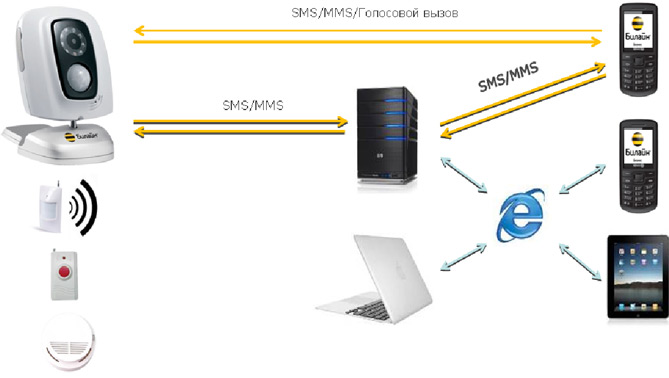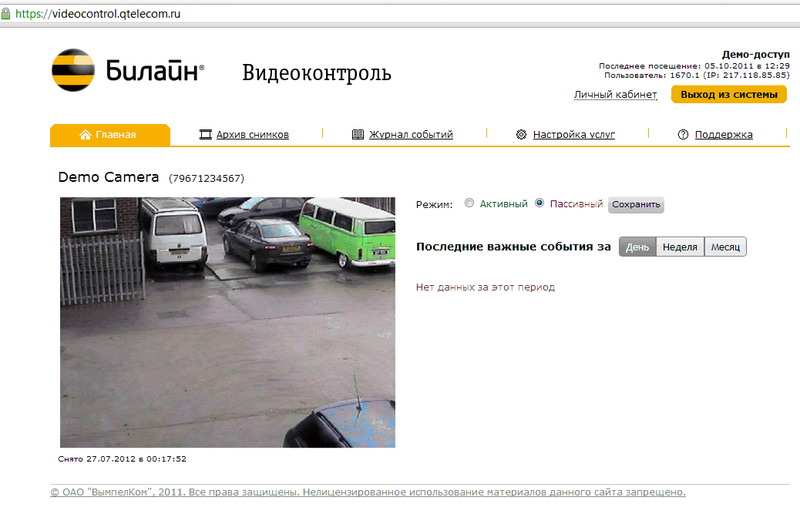Designer "Video Control"
 A couple of weeks ago, a series of practical tests ended, during which we tested a set of wireless cameras and various sensors to it. Actually, it was not even we who experienced, but several private security companies, who were happy to receive a new toy.
A couple of weeks ago, a series of practical tests ended, during which we tested a set of wireless cameras and various sensors to it. Actually, it was not even we who experienced, but several private security companies, who were happy to receive a new toy.In general, attempts to create a wireless camera that sends data using a SIM card have been made for a long time. A few years ago, the first solutions appeared that could be proud of the metal case, the dimensions of the half-brick and the Nokia battery on the good old Soviet bolts. They had to program them by sending SMS to the SIM-card inside, and they, in turn, gave the picture in response to an incoming message or simply by timer. Even these "dinosaurs" were already convenient for some objects, but things did not go further than a series of experiments.
There were several problems:
- The widespread 2G coverage then imposed restrictions on use: the cellular infrastructure was simply not ready to support such devices.
- There were no special tariffs for such cameras: operation was rather expensive.
- Management was difficult: you had to be an engineer in order to set everything up or reconfigure correctly.
- Due to the same difficulty with programming via SMS commands, setting up hundreds of cameras or reconfiguring them to another mode turned into a natural hell.
- The camera did not work with external sensors, which greatly limited its capabilities in practice.
')
We tried to figure out what hinders implementation the most and did this:
- We collected a normal, intuitive, control center: to set up the camera, just go to your personal account and click the options you want. It is very simple and does not even require reading the instructions.
- Created profiles for cameras: now it’s possible to roll one profile on hundreds of devices in two clicks.
- Let me remind you that at about the same time the standard scheme for building a remote object's security system was a star from the sensors, “tied” to the unit, which was able to process their data and send an alarm signal in case of something via a radio channel or wire. So, the camera still contained a module for transmitting data - so at the same time we “plugged” into it the lightweight functions of this unit, sufficient for standard use.
- Added to the camera and microphone so that you can call her and listen to the situation.
The result was such a designer of finished parts:
- A camera that can be placed on a horizontal surface or mounted on a vertical one.
- Motion sensor (volumetric sensor).
- Magnetic sensor door opening.
- Alert radio button.
- Smoke sensor
- Wireless siren.
You can connect to the camera any combination of sensors (including from various companies from other companies and simply assembled by security engineers) up to 15 pieces. The camera can handle events differently: for example, turn on the siren to trigger the door opening sensor, and send a photo to you; send SMS about smoke; photograph the movement in the room and put it in the archive; just shoot by timer and so on.

Channels - SMS, MMS, email, direct voice communication (listening to the built-in microphone). Pictures - JPEG up to 640x480, there is infrared illumination for darkened conditions. The camera works up to 24 hours from the battery (depending on the activity) and is charged via mini-USB.
Management via SMS is saved (sometimes it is necessary to do something urgently), while they can not be used at all - in your account you can make all the settings and at the same time view the archive of the camera snapshots and the event log. There you can add additional users who can watch the camera logs.
Practice
We showed the final complex to the private security companies and offered to run it in practice. As a result, most of those who took the test complex agreed that it was not worth using this profile instead of a full-fledged security system (no one has yet canceled the GSM jammer), but the option is quite suitable for monitoring .

Interface

Shot from our office

Sensors and prices
We know about the following cases in test operation:
- The camera with sensors was used to control access to the premises and filmed all the traffic there at night: the owner was looking for employees who were “walking” around the warehouse at night.
- The camera was placed in the car so that the owner could at any time get an MMS on the phone with a photo of the windshield and make sure everything is in order.
- The solution was installed in the nursery so that you can take a photo of the child and listen to what is happening.
- Unexpectedly, the owners of the stores became interested in the cameras, who needed to see the situation on the trading floor every 10 minutes, or to get information about what kind of customers enter the store at night.
- Cameras were tested on a network of gas stations to monitor the situation.
- Fleet solution liked the fact that you can observe the density of passengers in the cabin and get statistics on time.
- At remote sites, cameras are placed with various sensors and are used more as a transmitting unit with different features.
At the moment, there is a very big interest on the part of the PSCs regarding the decision: there is no talk about mass purchases, but many take 1-2 sets to study the decision. It is important that the camera plus sensors is not a security system, but a means of monitoring and informing that effectively and economically closes part of the tasks of the PSCs.
Source: https://habr.com/ru/post/160391/
All Articles